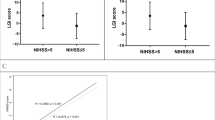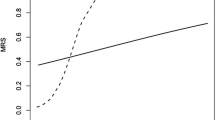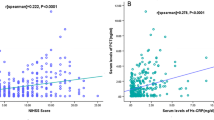Abstract
The value of C-reactive protein (CRP) as a prognostic tool in stroke patients is unclear. The aim of this study is to explore the prognostic impact of CRP levels assessed at different time points on functional outcome in a large cohort of thrombolysed acute stroke patients. All thrombolysed stroke patients admitted to our department were entered in an open, prospective database. Clinical and demographic data were recorded. CRP was measured upon admission, within 24 h, and in the following days. Functional outcome was assessed using the modified Rankin Scale (mRS) at 3 months. Among 1242 thrombolysed patients, we found a statistically significant difference in median CRP values upon admission, within 24 h, and follow-up with respect to outcome parameters (p < 0.001) including symptomatic intracerebral hemorrhage (sICH; p < 0.001). In regression models, follow-up CRP showed better predictive properties for outcome parameters compared to CRP assessed upon admission or within 24 h. The ROC analysis showed a good predictive value of follow-up CRP concerning dependent outcome [c-statistic 0.71 (95 % CI 0.67–0.75) p < 0.001] and mortality [c-statistic 0.70 (95 % CI 0.66–0.75) p < 0.001]. After adjustment for risk factors, follow-up CRP, but not admission CRP, was independently associated with dependent outcome (OR 2.67, 95 % CI 1.76–4.06; p < 0.001), mortality (OR 2.53, 95 % CI 1.50–4.25; p < 0.001), and sICH (OR 3.03, 95 % CI 1.51–6.06; p = 0.002). Follow-up CRP is strongly associated with functional outcome, sICH, and mortality after 90 days in thrombolysed stroke patients.

Similar content being viewed by others
References
Tousoulis D, Kampoli AM, Papageorgiou N et al (2011) Pathophysiology of atherosclerosis: the role of inflammation. Curr Pharm Des 7:4089–4110
Lakhan SE, Kirchgessner A, Hofer M (2009) Inflammatory mechanisms in ischemic stroke: therapeutic approaches. J Trans Med 7:97
Hasan N, McColgan P, Bentley P et al (2012) Towards the identification of blood biomarkers for acute stroke in humans: a comprehensive systematic review. Br J Clin Pharmacol 74:230–240
Whiteley W, Jackson C, Lewis S et al (2011) Association of circulating inflammatory markers with recurrent vascular events after stroke: a prospective cohort study. Stroke 42:10–16
Canoui-Poitrine F, Luc G, Mallat Z et al (2011) Systemic chemokine levels, coronary heart disease, and ischemic stroke events: the prime study. Neurology 77:1165–1173
Di Napoli M, Elkind MS, Godoy DA et al (2011) Role of c-reactive protein in cerebrovascular disease: a critical review. Expert Rev Cardiovasc Ther 9:1565–1584
Guasti L, Dentali F, Castiglioni L et al (2011) Neutrophils and clinical outcomes in patients with acute coronary syndromes and/or cardiac revascularisation. A systematic review on more than 34,000 subjects. Thromb Haemost 106:591–599
Clyne B, Olshaker JS (1999) The c-reactive protein. J Emerg Med 17:1019–1025
Ladenvall C, Jood K, Blomstrand C et al (2006) Serum c-reactive protein concentration and genotype in relation to ischemic stroke subtype. Stroke 37:2018–2023
Eikelboom JW, Hankey GJ, Baker RI et al (2003) C-reactive protein in ischemic stroke and its etiologic subtypes. J Stroke Cerebrovasc Dis 12:74–81
Idicula TT, Brogger J, Naess H et al (2009) Admission c-reactive protein after acute ischemic stroke is associated with stroke severity and mortality: the ‘bergen stroke study’. BMC Neurol 9:18
Luo Y, Wang Z, Li J et al (2012) Serum crp concentrations and severity of ischemic stroke subtypes. Can J Neurol Sci 39:69–73
Seo WK, Seok HY, Kim JH et al (2012) C-reactive protein is a predictor of early neurologic deterioration in acute ischemic stroke. J Stroke Cerebrovasc Dis 21:181–186
den Hertog HM, van Rossum JA, van der Worp HB et al (2009) C-reactive protein in the very early phase of acute ischemic stroke: association with poor outcome and death. J Neurol 256:2003–2008
Winbeck K, Poppert H, Etgen T et al (2002) Prognostic relevance of early serial c-reactive protein measurements after first ischemic stroke. Stroke 33:2459–2464
Di Napoli M, Papa F, Bocola V (2001) C-reactive protein in ischemic stroke: an independent prognostic factor. Stroke 32:917–924
Di Napoli M, Papa F, Bocola V (2001) Prognostic influence of increased c-reactive protein and fibrinogen levels in ischemic stroke. Stroke 32:133–138
Montaner J, Fernandez-Cadenas I, Molina CA et al (2006) Poststroke c-reactive protein is a powerful prognostic tool among candidates for thrombolysis. Stroke 37:1205–1210
Topakian R, Strasak AM, Nussbaumer K et al (2008) Prognostic value of admission c-reactive protein in stroke patients undergoing iv thrombolysis. J Neurol 255:1190–1196
den Hertog HM, van der Worp HB, van Gemert HM et al (2009) The paracetamol (acetaminophen) in stroke (pais) trial: a multicentre, randomised, placebo-controlled, phase iii trial. Lancet Neurol 8:434–440
Audebert HJ, Rott MM, Eck T et al (2004) Systemic inflammatory response depends on initial stroke severity but is attenuated by successful thrombolysis. Stroke 35:2128–2133
Youn CS, Choi SP, Kim SH et al (2012) Serum highly selective c-reactive protein concentration is associated with the volume of ischemic tissue in acute ischemic stroke. Am J Emerg Med 30:124–128
Ormstad H, Aass HC, Lund-Sorensen N et al (2011) Serum levels of cytokines and c-reactive protein in acute ischemic stroke patients, and their relationship to stroke lateralization, type, and infarct volume. J Neurol 258:677–685
Rocco A, Fam G, Sykora M et al (2012) Poststroke infections are an independent risk factor for poor functional outcome after three-months in thrombolysed stroke patients. Int J Stroke 8:639–644
Conflict of interest
A. Rocco has received speaker honoraria and travel expenses from Bayer Health care and Ever Pharma.
P. Ringleb has received speaker honoraria and travel expenses from Boehringer Ingelheim (Manufacturer of Alteplase) and is National Coordinator of SITS.
Author information
Authors and Affiliations
Corresponding author
Rights and permissions
About this article
Cite this article
Rocco, A., Ringleb, P.A., Grittner, U. et al. Follow-up C-reactive protein level is more strongly associated with outcome in stroke patients than admission levels. Neurol Sci 36, 2235–2241 (2015). https://doi.org/10.1007/s10072-015-2342-7
Received:
Accepted:
Published:
Issue Date:
DOI: https://doi.org/10.1007/s10072-015-2342-7




